====================
A homily offered by the Rev. Dr. C. Eric Funston on the Fourteenth Sunday after Pentecost, August 21, 2016, to the people of St. Paul’s Episcopal Church, Medina, Ohio, where Fr. Funston is rector.
(The lessons for the day are Proper 16C of the Revised Common Lectionary: Isaiah 58:9b-14; Psalm 103:1-8; Hebrews 12:18-29; and St. Luke 13:10-17. These lessons may be found at The Lectionary Page.)
====================
 Our reading from the Book of Isaiah today is the second half of chapter 58, a chapter which begins with God ordering the prophet to “Shout out,” to “do not hold back,” to “lift up [his] voice like a trumpet” with God’s answer to a question asked by the people of Jerusalem: “Why do we fast, but you do not see? Why humble ourselves, but you do not notice?” (Isaiah 58:1,3a)
Our reading from the Book of Isaiah today is the second half of chapter 58, a chapter which begins with God ordering the prophet to “Shout out,” to “do not hold back,” to “lift up [his] voice like a trumpet” with God’s answer to a question asked by the people of Jerusalem: “Why do we fast, but you do not see? Why humble ourselves, but you do not notice?” (Isaiah 58:1,3a)
God’s answer is simple: “You serve your own interest on your fast day, and oppress all your workers. [Y]ou fast only to quarrel and to fight and to strike with a wicked fist.” (vv. 3b-4)
The rest of the chapter, including the portion we heard today, is simply an expansion on that answer including (in this reading) God’s promise that a change of civic behavior, a change in the ruling elite’s treatment of the poor will be answered with prosperity for all. They had to choose what kind of community they were going to be. That was an important lesson for the ruling class to learn; it is an important lesson for us to learn. To fully understand the importance of this lesson, however, requires some placement of this prophecy in historical context.
The Book of Isaiah is not the work of a single prophet. Based on internal evidence and other historical data, scholars believe that in contains the oracles of at least three prophets or schools of prophets. The first, sometimes called “Proto-Isaiah,” comprises chapters 1 through 39. This writer lived and worked in Jerusalem before the Babylonian Exile. Chapters 40 through 54 are believed to have been written during the Exile recording the prophecies of the second or “Deutero-Isaiah.” The last of the book, chapters 55-66, contains short oracles of several post-Exilic prophets who are collectively known as third or “Trito-Isaiah.”
These “Third Isaiah” prophets were at work during the rebuilding of the Temple under the direction of Ezra the priest and Nehemiah the governor, whose names we know as the titles of the history books which tell that story. Professor Brian Jones of Wartburg college describes the social milieu of the time in this was:
Rebuilding the temple and the city was moving slowly, perhaps stalled completely. Leadership within the community was contested. Divisions and violent quarreling hindered progress in both physical and social restoration. Drought and food shortages exacerbated the social strife and made rebuilding difficult. Economic and social inequity – homelessness, hunger, lack of clothing – threatened the stability and identity of the returned community. (Jones, Working Preacher Commentary)
In addition, there was conflict between the returnees and those who had never left. The returnees disagreed about how welcoming their community should be to the locals who had remained; the leaders (particularly Ezra) were not welcoming at all.
Ezra and Nehemiah took an exclusivist position, regarding those who had remained and intermarried with other peoples to be less than Jewish. For example, “one of the first measures Ezra took was to make an ultimatum forcing all Jewish men to divorce their non-Jewish wives or at least have the women convert. Whoever refused would be excluded from the community.” (Jewish History, Ezra and Nehemiah) Ezra focused the people’s attention on rebuilding the Temple; Nehemiah focused on building a wall around Jerusalem. These, they believed, would bind the people as a nation and strengthen them to stand against their neighbors, friend and foe alike.
Others, however, promoted an inclusive viewpoint. For example, the Book of Ruth, which tells the story of a non-Jewish Moabite woman who married into Israel and became an ancestor of King David, was written during this period. The “Third Isaiah” prophets were of this viewpoint; they argued, as our reading makes clear, that welcoming the stranger, feeding the hungry, and meeting the needs of the afflicted were more important than building walls and, in the long run, would lay a foundation of prosperity for many generations.
Of course, Ezra and Nehemiah were in charge so the Temple and the wall were built, but the prophets turned out to be correct. The Temple and the wall did bind the people together, but Israel as a nation was never restored to the glory of the Davidic kingdom and for most of the next three hundred years was under the control of foreign empires ending, in Jesus’ time, with the Romans.
What Ezra and Nehemiah and their successors did accomplish was the creation of a relatively united and ritually pure Judaic religion, a faith which bound the people one to another and to their God. They might have minor disagreements about the relative importance of the festivals and sacrifices of the Temple as opposed to the rules and rituals of daily life, the disagreement between the Sadducees and the Pharisees, but in the end they were all Jews sharing one religion.
This was the religion into which Jesus was born, about which he taught, and the reform of which he sought. Our lesson from Luke’s Gospel today is a story of his effort to accomplish that reform.
As was his Sabbath custom, Jesus was teaching in a synagogue, the local religious meeting hall; Luke doesn’t tell us what village or town he was in, but somewhere in the region of Galilee. As he was teaching, a woman who was (the Greek tells us) “bent over double,” apparently with considerable curvature of her spine, entered. He called her to him and said, “You are freed,” not cured, freed, and laid his hand on her; she then stood up straight. Actually, was the Greek says is that “she was straightened.” It doesn’t say that Jesus straightened her, or that she straightened herself, simply that “she was straightened.” By what? By freedom and into freedom.
Of course, this astonishing event raises a commotion. The “leader of the synagogue,” a direct spiritual descendant of Ezra and Nehemiah, objects. Jesus, he argues, has violated the rules; he has done work (assuming that healing someone is work) on the Sabbath. Jesus answers in true rabbinic fashion employing what is known as arguing from the lesser to the greater. He reminds the leader and those around them that it is not a violation of the law to free a farm animal on the Sabbath so that it may drink; if this, the lesser thing, is permitted, then it must also be true that to free a Jewish woman, a “daughter of Abraham,” from her ailment, the greater thing, is also permitted.
Many commentaries make not of the fact that this woman, by reason of her spinal curvature, her being bent over double could never have looked anyone in the eye, could not have seen the horizon, could only look at her feet and the few feet of ground that lay before her. She was cut off from the world around her. The leader of the synagogue and other spiritual descendants of Ezra and Nehemiah were similar blinded by their rules and traditions.
The rules of the Sabbath on which the synagogue ruler bases his objection are not to be found in the Law of Moses; they are not in the Torah. Instead, these are the mitzvoth d’rabbanan, the man-made laws intended by the rabbis to be a fence or wall around the Torah, lesser (but just as strenuously enforced) ritual rules that insured one did not break a commandment of the Scriptures.
Although this gospel story is often presented as just one more of Jesus’ healing miracles, I suggest to you that it is much, much more. It is a story of liberation, not only of the woman herself, but of all those who were present and all those, like ourselves, who have heard it through the ages. In this story, Jesus frees them and us from the bondage of inflexible rules, from the walls we have built around our hearts and our spirits.
The leader of the synagogue and generations of tradition had made the ritual observance of the Sabbath more important than the people for whom the Sabbath was meant. Sabbath (the Hebrew word literally means “rest”) was intended to give the people of God freedom from the demands of everyday life; it was to be a time of rest, relaxation, and refreshment. But in trying to guard that time of liberation, the rabbis had built their wall of rules, their “fence around the Torah,” rituals which were more restrictive, more demanding than the strictures of daily life. It is not in this text but in the Gospel of Mark that Jesus says to the Pharisees, “The Sabbath was made for humankind, and not humankind for the Sabbath” (Mark 2:27), but that is certainly the message of this story. The Sabbath is no reason to refuse healing and liberation to a “daughter of Abraham.” As St. James would later write to the church, “Religion that is pure and undefiled before God, the Father, is this: to care for orphans and widows in their distress, and to keep oneself unstained by the world.” (James 1:26)
We often focus too much on the “keeping unstained” and too little on the care of the poor. That was the problem the Third Isaiah oracles sought to address, the focus on the wall of security around the city and on the purity of the temple. A Quaker preacher in North Carolina has written about our Isaiah lesson as follows:
If ever there was an unambiguous prophetic signpost for the people of Israel that would show them the way to a restored relationship with Yahweh, Isaiah’s message in Chapter 58:10 was it: “If you offer your food to the hungry and satisfy the needs of the afflicted, then your light shall rise in the darkness and your gloom be like the noonday…”
While so many of the Old Testament prophets’ messages are filled with jeremiads of doom and gloom, this positive passage is exceptional in that it holds out the conditional promise of personal and community restoration and reconciliation, expressed poetically as a “watered garden” (v.11). The condition was clear: first the Israelites had to feed the hungry, comfort the afflicted, and treat their neighbors as they would themselves like to be treated. The power of this poetic passage speaks volumes for the spirit of love, compassion, and neighborliness which God expects God’s people to demonstrate as they go about feeding the hungry in their communities. The hungry were not to be subject to a “means” test, speak only one official language, or show documents to prove they were not “illegal” before they were to be fed. They were to be fed simply because they were hungry.
God does not say here, “The poor you have with you always, so relax, take your time, pay your bills, balance your budget, play the lottery, fill up the SUV, take a vacation, and, if there are any crumbs left on the table, offer pennies to the hungry.” Rather, God clearly gives feeding the hungry top priority on the daily agenda of God’s people rather than fighting terrorism and protecting one’s job security, life insurance, college savings program, or retirement investment.
The bottom line in this text from Isaiah is not maximization of profits, but feeding the hungry and comforting the afflicted. (Ed King, Member, Chapel Hill Friends Meeting)
As for the Third Isaiah prophets, so too for Jesus. “God’s time,” writes Lutheran pastor Amy Lindeman Allen about the gospel story, “is a time that, no matter when it is observed (and, for Jesus and the synagogue leader, this would have been a Saturday) and no matter how it is observed in the particulars, it is always and only about life.” This story demonstrates that for Jesus, Sabbath is “always about God’s people and their well-being, and not simply about the ‘rules’ and the way we wish things ought to be.” (Political Theology)
These stories today are coupled with a frankly strange bit of prose cut out of the Letter to the Hebrews. The writer of the letter contrasts two mountains, Sinai where the Law was given and Zion to which those finding freedom in Christ are invited. The first place is “ominous for the eye and the ear with burning fire, darkness, gloom, windstorm, [and the] noise of trumpets.” (Peeler, Working Preacher Commentary) The second is a place of life and light, of festivity, of angels, and of “the firstborn who are enrolled in heaven.” The author of Hebrews encourages us to accept the invitation, “See that you do not refuse!” We are being offered a kingdom, a community that cannot be shaken, a community where the finger is not pointed, where evil is not spoken, where the hungry are fed, the afflicted cared for, the stranger welcomed, where bones are made strong, where backs are straightened and youth is renewed.
These lessons today are about our communities, religious and secular, local and national, and the role and function of our laws, our rules, and our traditions; they test our claims about what could and should be practiced within our communities, and about who is allowed within our walls. They ask us, and demand that we answer. What kind of community – what kind of church, what kind of city, what kind of state, what kind of nation – do we want to be? An exclusive community encircled by walls and bound by restrictive rules, or an unshakeable inclusive community of life and light and freedom. The choice is ours. Amen.
====================
A request to my readers: I’m trying to build the readership of this blog and I’d very much appreciate your help in doing so. If you find something here that is of value, please share it with others. If you are on Facebook, “like” the posts on your page so others can see them. If you are following me on Twitter, please “retweet” the notices of these meditations. If you have a blog of your own, please include mine in your links (a favor I will gladly reciprocate). Many thanks!
====================
Father Funston is the rector of St. Paul’s Episcopal Church, Medina, Ohio.
 In philosophy and theology there is an exercise named by the Greek word deiknumi. The word simply translated means “occurrence” or “evidence,” but in philosophy it refers to a “thought experiment,” a sort of meditation or exploration of a hypothesis about what might happen if certain facts are true or certain situations experienced. It’s particularly useful if those situations cannot be replicated in a laboratory or if the facts are in the past or future and cannot be presently experienced. St. Paul uses the word only once in his epistles: in the last verse of chapter 12 of the First Letter to the Corinthians, he uses the verbal form when he admonishes his readers to “strive for the greater gifts. And I will show you [deiknuo, ‘I will give you evidence of’] a still more excellent way.” It is the introduction to his famous treatise on agape, divine love, a thought experiment (if you will) about the best expression, the “still more excellent” expression of the greatest of the virtues.
In philosophy and theology there is an exercise named by the Greek word deiknumi. The word simply translated means “occurrence” or “evidence,” but in philosophy it refers to a “thought experiment,” a sort of meditation or exploration of a hypothesis about what might happen if certain facts are true or certain situations experienced. It’s particularly useful if those situations cannot be replicated in a laboratory or if the facts are in the past or future and cannot be presently experienced. St. Paul uses the word only once in his epistles: in the last verse of chapter 12 of the First Letter to the Corinthians, he uses the verbal form when he admonishes his readers to “strive for the greater gifts. And I will show you [deiknuo, ‘I will give you evidence of’] a still more excellent way.” It is the introduction to his famous treatise on agape, divine love, a thought experiment (if you will) about the best expression, the “still more excellent” expression of the greatest of the virtues.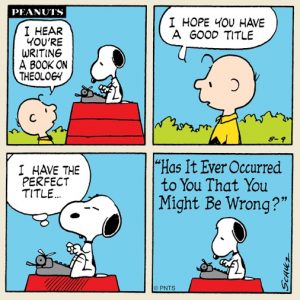 God’s response to Abraham’s challenge is to take Abraham outside and show him the stars and ask him, “Has it ever occurred to you that you might be wrong?” Well, God doesn’t, actually . . . but that’s what it boils down to. God’s response to Abraham is, “Thank again!”
God’s response to Abraham’s challenge is to take Abraham outside and show him the stars and ask him, “Has it ever occurred to you that you might be wrong?” Well, God doesn’t, actually . . . but that’s what it boils down to. God’s response to Abraham is, “Thank again!”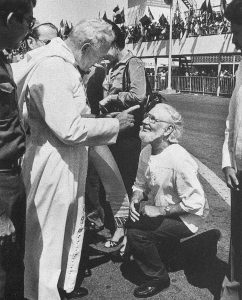 When Pope John Paul II scolded Fr. Cardenal upon the his arrival in Nicaragua, it was because Cardenal had collaborated with the Marxist Sandinistas and, after the Sandinista victory in 1979, he became their government’s Minister of Culture. His brother, Fr. Fernando Cardenal S.J. also worked with the Sandinista government in the Ministry of Education, directing a successful literacy campaign. There were a handful of other priests working in the government, as well.
When Pope John Paul II scolded Fr. Cardenal upon the his arrival in Nicaragua, it was because Cardenal had collaborated with the Marxist Sandinistas and, after the Sandinista victory in 1979, he became their government’s Minister of Culture. His brother, Fr. Fernando Cardenal S.J. also worked with the Sandinista government in the Ministry of Education, directing a successful literacy campaign. There were a handful of other priests working in the government, as well. 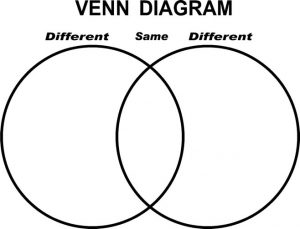 We know that if there are tribal circles on that foundational paper, they are more like the circles on a Venn diagram, not only touching but overlapping. That was true of the ancient Hebrews; their tribalism might demand ethnic purity, but they never achieved it; the Old Testament demonstrates that, again and again! Modern ideological tribalism is no different. Ideologies, religious beliefs, political opinions differ in many ways, but in many others they share much in common; they overlap. People’s lives and opinions overlap, but ideological tribalism encourages us to hear only the differing opinions and blinds us to our similar lives.
We know that if there are tribal circles on that foundational paper, they are more like the circles on a Venn diagram, not only touching but overlapping. That was true of the ancient Hebrews; their tribalism might demand ethnic purity, but they never achieved it; the Old Testament demonstrates that, again and again! Modern ideological tribalism is no different. Ideologies, religious beliefs, political opinions differ in many ways, but in many others they share much in common; they overlap. People’s lives and opinions overlap, but ideological tribalism encourages us to hear only the differing opinions and blinds us to our similar lives. Languages and the study of languages fascinate me – if you didn’t know that before this series on the Lord’s Prayer, you probably know it now – and I am therefore always keenly aware of the difficulty of fully appreciating the Holy Scripture if we only consider the meaning of the English translation.
Languages and the study of languages fascinate me – if you didn’t know that before this series on the Lord’s Prayer, you probably know it now – and I am therefore always keenly aware of the difficulty of fully appreciating the Holy Scripture if we only consider the meaning of the English translation. 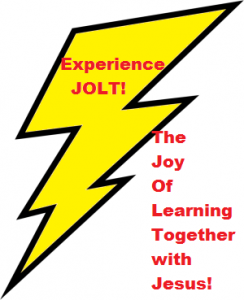 When you sit there in the pew and I stand here in the pulpit and say to you “The Bible says this . . . .” or “The Church teaches that . . . .”, how do you know that I’m telling you the truth? When the writer of the Letter to Hebrews admonishes you to “approach [the sanctuary of God] with a true heart in full assurance of faith,” how do you have that assurance? When that writer, again, encourages you to “hold fast to the confession of our hope without wavering,” how do you know what that confession is? And when Jesus commands you, “Beware that no one leads you astray,” how do you make the judgment to exercise that caution?
When you sit there in the pew and I stand here in the pulpit and say to you “The Bible says this . . . .” or “The Church teaches that . . . .”, how do you know that I’m telling you the truth? When the writer of the Letter to Hebrews admonishes you to “approach [the sanctuary of God] with a true heart in full assurance of faith,” how do you have that assurance? When that writer, again, encourages you to “hold fast to the confession of our hope without wavering,” how do you know what that confession is? And when Jesus commands you, “Beware that no one leads you astray,” how do you make the judgment to exercise that caution?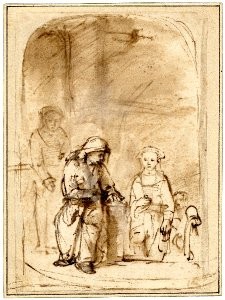 I get letters. Sometimes they’re really nice letters. And sometimes they’re not. Today, I want to tell you about a letter and how it caused me to rethink the two stories of women in today’s lectionary readings: First, the end of the story of Ruth from the biblical book named for her, and second, the story of Jesus watching and commenting upon the sacrificial giving of a widow in the Jerusalem temple.
I get letters. Sometimes they’re really nice letters. And sometimes they’re not. Today, I want to tell you about a letter and how it caused me to rethink the two stories of women in today’s lectionary readings: First, the end of the story of Ruth from the biblical book named for her, and second, the story of Jesus watching and commenting upon the sacrificial giving of a widow in the Jerusalem temple.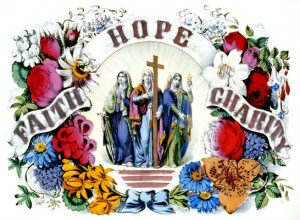 Last week, I gave away the ending of Job. I told you that everything turned out all right in the end, and so it has. Job has repented, not of any sin that warranted his suffering, but of the pride and arrogance (and ignorance) he displayed during his suffering by demanding to confront God. God has forgiven him and to make up for all his loss, his fortunes have been restored many times over. Happy ending! Except not quite . . .
Last week, I gave away the ending of Job. I told you that everything turned out all right in the end, and so it has. Job has repented, not of any sin that warranted his suffering, but of the pride and arrogance (and ignorance) he displayed during his suffering by demanding to confront God. God has forgiven him and to make up for all his loss, his fortunes have been restored many times over. Happy ending! Except not quite . . . 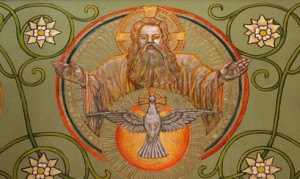 What is Lent all about?
What is Lent all about? I cannot read these verses of Hebrews (nor the verses of Psalm 8 which the author quotes) without thinking of Hamlet:
I cannot read these verses of Hebrews (nor the verses of Psalm 8 which the author quotes) without thinking of Hamlet:

